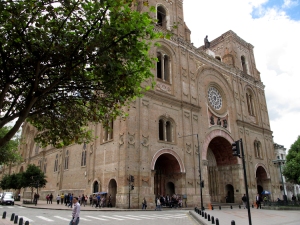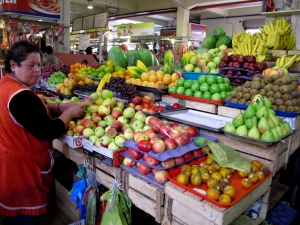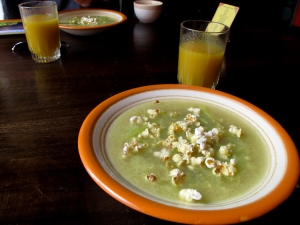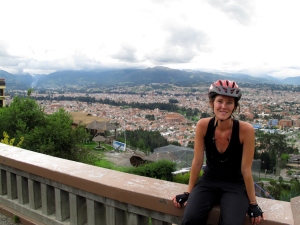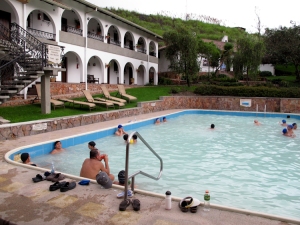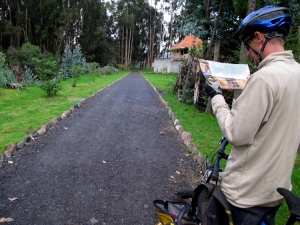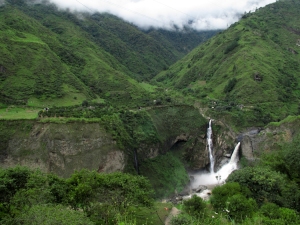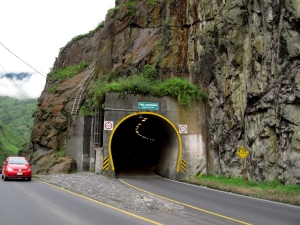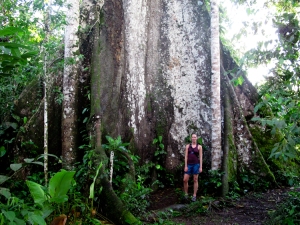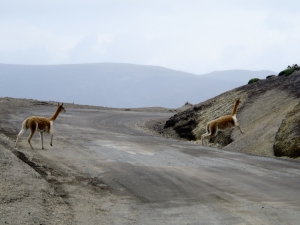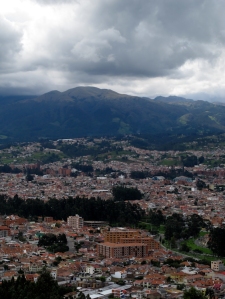
Cuenca is such a great city! Tons of beautiful churches and green parks. Last night, after C and I arrived in town after a four hour bus ride from Guayaquil, we explored the cobblestone streets of Cuena and admired its old colonial building, remnants of Spanish colonizations in the mid-1500’s. We had a late afternoon snack of hummus (yay!) and then a light dinner at Raymipampa. I’ve been craving salads and luckily they had a great lettuce, bean, and avocado option for me! The hotel we’re staying at – Macondo – is on the outskirts of the center of town, which is fine with me because it’s quiet at night. The hotel reminds me a lot of the place we stayed at in San Jose (Aranjuez) because it’s an old converted house centered around an open courtyard.
In the morning we ate breakfast with some other travelers and had a leisurely start to the day. The plan was to walk around Cuenca some more, but other than that our agenda was open. We found our way to a giant indoor food market with vendors selling everything from fruits, vegetables, eggs, meat, cooked legumes and almost anything else you can think of, including fresh carrot and apple juice! Except for a juice and some bananas, we didn’t buy anything, but vowed to return later to stock up on a few mangos and avocados.
Our next destination was the Museo del Banco Central. Now, I’m not a museum person, but we spent about an hour walking through the exhibits showcasing the history and archaeology of indigenous populations. By that time I had had enough of museums for a week, so we continued on our way. We stopped in at a local travel agency and inquired about bikes to rent. We were in luck because they had two brand new bikes for only $8 for half a day. C and I said we would return after lunch and take them for a spin. For lunch I was eager to try a restaurant called Nectar, which is %100 vegan. The inside was really cute with wooden tables and nice decor. The menu was a set lunch, so we sat down and waited to be served. We had broccoli soup topped with popcorn (per the Ecuadorian way), fresh tree tomato juice (also an Ecuadorian special), a mix of potatoes in some sort of gravy, cabbage, beets, and a small salad. For dessert, it was some sort of sweet barley (I think) pudding. It was good, but not exceptional.
After lunch, we returned to the hotel to change into biking gear, and then returned to the tour office. Our speedily devised route was to bike up to the Mirador de Turi, a lookout point about 4km outside of town and then continue on 8km to a small town called Baños (not the one we visited on Arie’s bike trip) where there are several thermal hot springs. The bike up to the top of the lookout was somewhat challenging (we’re at 8,000 feet here), but felt great after being at sea level for a week and a half. I’ve wondered several times these last few weeks about how frequent and rapid elevation changes affects your body and mind…
After snapping a few photos of Cuenca from above, we coasted back down the hill and pedaled on to Baños. According to our guide book, the best place for a soak is at Hosteria Durán, so that’s where we went. We payed the fee and brought our bikes inside the gate where we were could see the large thermal pool occupied by several bathers and a small building up on a hill that housed the steam room. We opted for the steam room first, which felt great, and then headed down to the swimming pool filled with warm volcanic waters. It felt fantastic! We soaked for awhile before returning to the steam room and then settling down into wicker chairs for a cup of tea (me) and coffee (C).
It started to drizzle a bit, but nothing too depressing and as we bundled up and rolled out of the parking lot, we could barely tell that it was raining. Luckily, the ride back into town was mostly downhill because I felt pretty rubbery from all that warm water. We sort of zig-zagged back into the city without a direct route, but we did find a nice gravel path that ran alongside the River Tomebamba that splits Cuenca in two. The light was fading as we brought the bikes back to the tour office and since it’s a 10 minute walk back to the hotel, we opted to stay downtown for dinner despite the mud on our faces and clothes.
Tomorrow, depending on the weather, we’re hoping to do some hiking in Cajas National Park, dubbed “one of the most beautiful wilderness areas in Ecuador” by our Rough Guides guide book. Can’t wait!
Filed under: Ecuador, Food & Restaurants, Travel | Tagged: banos, biking, Cajas National Park, cuenca, Ecuador, guayaquil, mirador del turi, South America, thermal baths, Travel, vegan | Leave a comment »


